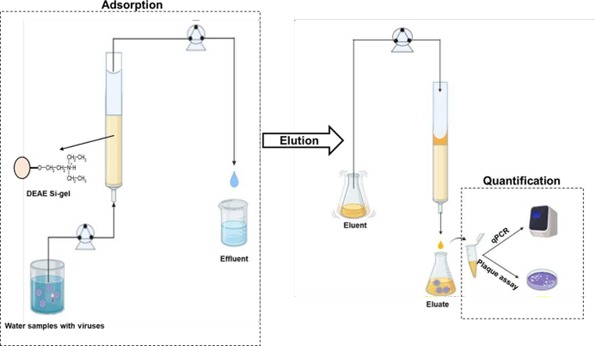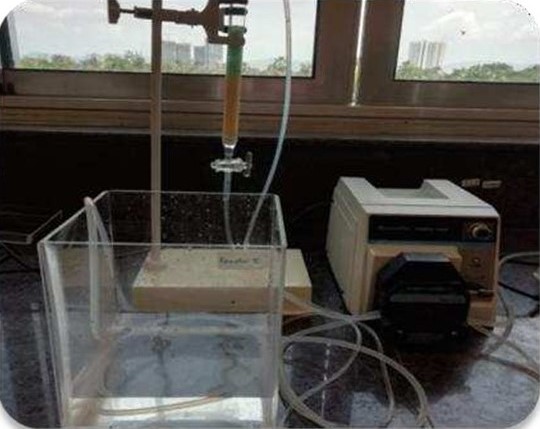This current invention presents a DSiG packed column method for efficient virus concentration from water samples. The approach enabled effective adsorption and elution of coliphages, MS2, SUSP2, and an enteric virus, rotavirus A (RVA) at both low and high flow rates. High recovery was achieved even at low viral concentrations, and successful application to environmental water samples highlights its potential for detecting viruses in drinking water sources.
Existing virus concentration methods such as filtration and ultracentrifugation are time-consuming, require specialized equipment, and are inefficient for large-volume water samples, especially when viruses are present at extremely low concentrations. These limitations hinder rapid monitoring and outbreak detection in environmental and public health contexts.
- High Virus Recovery Efficiency: The innovation achieves over 90% recovery of viruses like MS2 and SUSP2 from large water volumes using a DSiG-packed column and virus-specific eluents (ES-2 and FM-3).
- Rapid and Scalable Process: It reduces concentration time from ~100 hours (ultracentrifugation) to just 3-4 hours, making it suitable for high-throughput or emergency testing scenarios.
- Sensitive Detection Capability: It is capable of detecting viruses at extremely low concentrations (<1 copy/L), supporting early warning systems for waterborne pathogens.
- Low-Cost and Reusable Setup: It utilizes relatively inexpensive and regenerable materials, significantly lowering operational costs and making it ideal for resource-limited settings.
- Broad Virus Compatibility: It has demonstrated high efficiency for diverse viruses, such as coliphages and Rotavirus A, supporting its applicability in both environmental and potential clinical settings.
The prototype consists of a packed column with a diameter of 2.2 cm and a depth of 10 cm, filled with DSiG particles ranging from 75-150 µm. Water samples are passed through the column at a flow rate of 50 mL/min, allowing efficient virus adsorption. Specific eluents are used for virus desorption: Na (1.5 M)-Tw (3%) for SUSP2 and Na (1.5 M)-Tw (2%)-G3X for MS2 and RVA. After elution, viruses are further concentrated using polyethylene glycol (PEG 6000) precipitation with 2% NaCl. The final viral RNA is isolated and quantified using reverse transcription followed by qPCR analysis.
The technology has reached TRL 5 – validated using real-world environmental water (lakes) under lab-controlled conditions. Effectively tested on real-world environmental samples, demonstrating strong potential for application in the concentration of viruses from drinking water sources with very low viral loads.
5
The technology significantly enhances public health surveillance by enabling early detection of viral pathogens in drinking water and the environment. It supports pandemic preparedness through reliable monitoring of enteric viruses like Rotavirus A. Its low-cost, scalable design suits rural and urban water quality monitoring and offers a practical alternative to ultracentrifugation, especially for resource-limited settings.
- Environment and sustainability
- Healthcare and medical devices (Public health surveillance)
- Water and wastewater monitoring
- Municipal water utilities
- Virology research laboratories
- Agricultural water safety
Geography of IP
Type of IP
202021006972
549094


